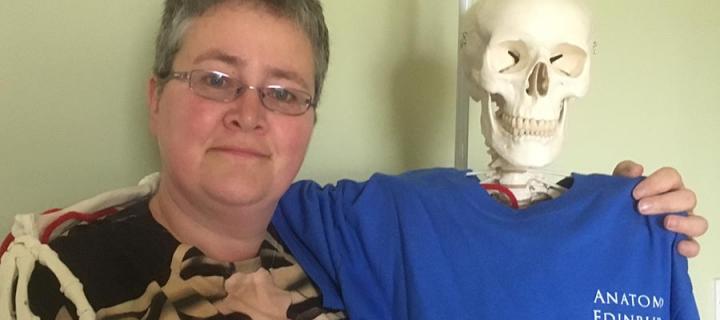Inspired by Burke
This month we focus on Janet Philp, Head of Administration in the Deanery of Biomedical Sciences, sporting guru, and author of a new book about one of Edinburgh’s most notorious residents.

Janet’s first experience of Edinburgh was in 1988 during her year out while studying Applied Biology at North East London Polytechnic. She was one of five students from her course selected to work at Moredun Research Institute in Liberton. Shortly after completing her degree in London she returned to Moredun and Edinburgh, married, and joined a research group focussing on tuberculosis amongst wild red deer.
After departing Moredun for the Roslin Institute, Janet started working in research for the University of Edinburgh in 1997, firstly in pathology, then molecular biology. However, her job eventually morphed into an administrative position and these days she looks after the daily administration of her Deanery in the Hugh Robson Building in George Square.
Sporting endeavours
After the birth of her second child in 2002 Janet decided to take up Taekwondo. Not only does she hold a black belt in the Korean martial art, she also represented the UK at the 2007 World Championships. To add to her sporting accolades Janet was the first female rugby referee in Edinburgh after retiring from playing several seasons as tight-head prop for Lismore Ladies. Rugby and Taekwondo might seem varied enough, but Janet also added a stint as aerobics teacher at Moredun, Zumba teacher at the University, archery instructor, and gaining a certificate in Budokon - a rather impressive sporting CV.
Inspired by the Anatomical Museum
Over the past few years, Janet has worked increasingly closer with colleagues in the Anatomical Museum housed on the top floor of the Old Medical School at Teviot Place. It’s well known for one its most popular exhibits - the skeleton of William Burke who was hanged in 1829 for his part in the West Port murders. And this has now inspired Janet, with the infamous criminal being the subject of her new book, Burke: Now and Then.
Discoveries
A conversation about the genetic sequencing of Burke and the possibility of descendants and inheritable diseases was what first sparked Janet’s interest. Investigating these unknowns involved an impressive amount of collaborative work across the University. Janet acquired the help of Dr Tim Kendall, Senior Clinical Fellow in Pathology, and, crucially, Felicity Loughlin from the School of History, Classics and Archaeology, who translated Burke’s medical report from Latin before any answers could be found.
Janet spent many lunchtimes in the University’s Centre for Special Collections and it soon became clear that she was discovering too much interesting content for a paper and writing a book was the only answer. Among her findings were the fact that Burke did not have testicular cancer, as previously supposed, and that he did have a niece, which had not been previously documented.
Writing the book has made me appreciate what a great network of experts we have available in the University. It was a real example of interdisciplinary collaboration.
Burke: Now and Then
Janet’s new book is being launched on 1 November 2016. In line with the roots of her writing project, 45% of the profits will go to the Anatomy Department to ensure the continuing use of cadaveric material in teaching and engagement, and 10% to the Oddballs Foundation for testicular cancer.
Some of the profits are going to ensure that OddBalls continue raising the awareness of testicular cancer, a cancer that has an almost 99% survival rate if detected early enough.
Attend the book launch
There is a limited amount of tickets available to the book launch event, taking place in the Anatomy Lecture Theatre at 7pm on Tuesday, 1 November.
Get your tickets to the book launch

